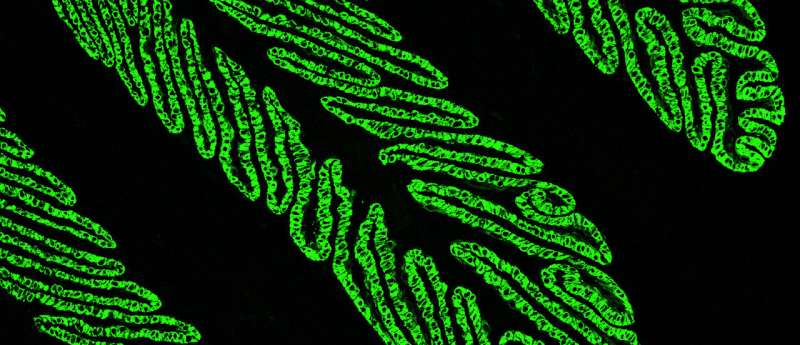Laminitis insights show promise for the future of treatment

Horse owners usually dread hearing the diagnosis of laminitis. The disease plagues horses of many backgrounds, ages, and disciplines. Now, using genetics, scientists from Penn's School of Veterinary Medicine and the University of Florida (UF) have made new insights in the disease. Their findings appear in the journal Veterinary Immunology and Immunopathology.
A horse's hoof has a tough job. It must support a heavy animal which can move faster than 40 miles per hour. Laminitis occurs when inflammation and damage of the tissue arises between the hoof and coffin bone. The condition causes lameness and a diminished quality of life, and it often results in euthanasia.
"Laminitis is a tough problem for the horse and its owner," says Samantha Brooks, UF associate professor of equine physiology and the corresponding author on the work. "We have very few tools in our arsenal to manage the disease itself. We treat symptoms, pain, and mechanical instability but do not have anything to target the cause just yet."
"By tapping into my lab's database and incorporating Dr. Brooks' unparalleled expertise in equine genetics and transcriptome analysis, we have identified new and promising pathways in cell stress and inflammatory response that significantly enhance our understanding of supporting limb laminitis and its disease processes," says Hannah Galantino-Homer, senior investigator in laminitis research at Penn Vet's New Bolton Center and a coauthor on the paper.
Laminitis studies have previously been hindered by the scarcity of genetic information specific to hoof tissues. Scientists tapped into the New Bolton Center Laminitis Discovery Database, an archive of data and sample sets from naturally occurring laminitis cases collected since 2008. Using that database, researchers examined 36 archived tissues of 20 Thoroughbred horses treated for laminitis.
There are three types of laminitis, and all impair the structure and function of the horse's foot. This research provided a snapshot of the active pathways and functions of the hoof, with a focus on supporting limb laminitis, the kind to which famous racehorse Barbaro succumbed.
"We understand the situations that trigger an episode of laminitis, but we do not have a good understanding of what is happening in the hoof," says Brooks. "This study took a very comprehensive view of the processes early in the development of laminitis."
Using gene-expression analysis, researchers cataloged the changes in gene transcription across the 20 horses. Some had healthy feet, some were early in the disease process, and others were more severe.
Researchers identified three key findings about the disease process.
The first related to keratin, an important structural protein that helps maintain the structural integrity of materials like hair, nails, and hooves. This study was one of the first to examine the changes in the keratin protein family through the laminitis disease process. Some of the keratin-related genes and genes involved in regulating of the cell's manufacturing process started to diminish as the disease began. This could be compared to when a car gets a flat tire; it may still be running, but it loses appropriate function and slows down.
Another component of cell machinery often studied in laminitis is a class of enzymes called metalloproteinases that help maintain the cytoskeleton. These enzymes must maintain a careful equilibrium. Hooves must be able to grow yet not break down under the weight of the horse, which requires a balance of remodeling and building tissues. When the metalloproteinases become too active, the hoof begins to lose structural strength. One previous strategy for treating this process was to stop these enzymes from becoming too active. But treatment targeting these enzymes might also stop hoof growth, which would likely lead to further problems.
When keratin degrades, inflammation in the hoof leads to laminitis. Scientists found a collection of genes responsible for triggering that inflammation which could pave the way for future therapies. The genes led researchers to believe that some human medications for autoimmune disorders may help horses with laminitis.
Changes in gene expression in diseased tissue are often reflected in changes in the proteins that can be detected in the blood as the disease progresses. For example, specific proteins, or biomarkers, that increase in the blood in humans following traumatic brain injury were also expressed at higher levels in the samples from the horses with laminitis in this study. Medical doctors have used these compounds to understand the severity of these injuries in humans without using imaging or more invasive testing. The team hopes this could be used as a tool to monitor the progression of laminitis in the horse.
"We don't always recognize that a horse has severe laminitis until things have gotten quite bad," says Brooks. "Early monitoring tools and ways to combat the disease were exciting findings, but we need further research before these new tools will be ready for use in the field."
The researchers hope that this research can lead to a blood test to detect these new laminitis-related biomarkers as well as medications that are economical and effective for horses with the disease.
"Ultimately, these new findings point us towards a more targeted approach for future exploration that we hope will help uncover novel solutions for preventing and treating this debilitating disease," says Galantino-Homer.
"This is a big step in improving our understanding of laminitis," says Brooks. "Something that could be completely untreatable 10 years ago; in another 10 years we may be able to intervene and make a significant difference in the disease early on."
More information: Heather M. Holl et al, Transcriptome diversity and differential expression in supporting limb laminitis, Veterinary Immunology and Immunopathology (2021). DOI: 10.1016/j.vetimm.2021.110353
Provided by University of Pennsylvania




















